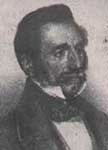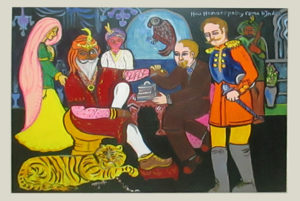 Johann Martin Honigberger M.D. (10 March 1795 – 18 December 1869) was a Romanian Saxon orthodox physician who converted to homeopathy, and who introduced homeopathy into Afghanistan, Egypt, Persia, Romania, Russia, Turkey, India and Pakistan.
Johann Martin Honigberger M.D. (10 March 1795 – 18 December 1869) was a Romanian Saxon orthodox physician who converted to homeopathy, and who introduced homeopathy into Afghanistan, Egypt, Persia, Romania, Russia, Turkey, India and Pakistan.
In 1835, Honigberger visited Samuel Hahnemann, and he was a speaker of the Romanian language and had practised homoeopathy in all three Romanian principiates.
Honigberger also discovered ancient Buddhist scrolls at Gandhara, and recorded some Sikh history whilst travelling for the East India Company.
Dr. Honigberger was born at Kronstadt (modern Brasov), a town in Transylvania, Romania. After passing his M.D. with distinction, he became a successful practitioner. Dr. Honigberger arrived at Lahore in 1829-30 and was later invited to treat the Maharaja Ranjit Singh of Punjab (Honigberger treated the Maharaja for paralysis of th
e vocal cords with swelling of the feet, dispensing Dulcamara in wine, in low potency, which cured him. The Maharaja was also impressed when Honigberger cured his favourate horse of ulcer of the leg).
Later he stayed on in Lahore even after the death of Maharaja Ranjit Singh. He wrote a book about his experiences, titled Thirty Five Years in the East.
He came from his native country, Transylvania through Levant, Egypt, Arabia and Persia and then on to India. He resided for about 15 years in the Punjab and returned via Afghanistan, Bokharo and Russia.
He left his native town in 1815 for Constantinople. Later in 1817 he visited Jerusalem and as a physician to the Governor of Toccata he traveled with him to Asia Minor. His first patient at Lahore was the adopted son of General Allard.
His fame spread only when he treated and cured some soldiers who had been bitten by a mad jackal and were beginning to show signs of hydrophobia, after some soldiers had already died of the bite. Maharaja Ranjit Singh was impressed by him when he treated his favorite horse of its bad ulcers of the leg. The Maharaja had come to have great confidence in him and made him accept the management of a gunpowder manufactory and also a gun stock establishment.
Being homesick, Honigberger went back in 1834. Next year he went to Paris and met Samuel Hahnemann and his wife. Later on the advice of Samuel Hahnemann, he bought a large quantity of homeopathic medicine from Hahnemann’s Pharmacist, Lehmann of Kothen.
In the year 1836, he happened to go to Vienna and caught an infection of cholera, which was raging there. He saved himself by taking Ipecac every half an hour. He was impressed greatly by the results of homeopathic medicine both in himself and others.
He decided to start his practice at Constantinople. He treated cases of Plague with Ignatia. He was led to use it because he saw Armenians there wearing a string tied to a bean of Ignatia and it seemed to give them protection where so many people were dying every day. He also treated a case of haemorrhage with Aranea diadema, which brought him both name and fame.
He had a very lucrative practice. On learning that Maharaja Ranjit Singh wanted him back, he reached Lahore in 1839 in the company of General Venture after an adventurous journey.
After the death of the Maharaja his position and influence waned till Sardar Jawahar Singh came to power, and restored him to his former position as Court Physician and Director of the gunpowder mill.
In 1849, the Punjab was annexed by Sir Henry Lawrence. With the abolition of the Sikh Darbar he had to relinquish his post. He was granted a pension. Later he returned to his country…. He was the first man to introduce the name of Samuel Hahnemann and his healing art to India.
Honigberger returned to his home town of Brasov where he died in December 1869.
Select Publications:
- Thirty Five Years in the East 1815 – 1850 (1852)
- Heilung der Indischen Brechruhr Durch Einimpfung des Quassins (Cure of Indian Dysentery by Inoculation of Quassin) (1859)
- Die Cholera Deren Ursache und Unfehlbare Heilung und die Epidemien im Allgemeinen (Cholera, Its Cause and Infallible Cure and Epidemics in General) (1865)



HELLO.
I LIKE VERY MUCH THIS HISTORY . WHEN I READ THIS HISTORY I WAS SHOCKED .HOMOEO CAME BY MAHARAJA RANJIT SINGH JI.
I AM WORKING IN HOMOEO PATHIC COMPANY. MY COMPANY NAME IS DR.WILLMAR SCHAWABE INDIA PVT LTD.
VANEET SHARMA
In 1839, Dr Honigberger came to Lahore along with the Homoeopathic medicines, he had procured from Hahenman. He was summoned by Ranjit Singh, who was suffering from paralysis of tongue and swelling of feet. Honigberger prescribed Tincture Dulcamara, one drop on sugar cube to Maharaja, and his condition improved but Council of Indian physicians attending the Maharaja gave him Jawahrid Majoon (a concoction of gems, mercury etc). As a result of which Maharaja died.
Honigberger’s book, “Thirty five years in the East” gives a very good account of Botanicals used at that time. IT IS A MUST READ BOOK.
Thank you for using my painting about Maharaja Ranjeet Singh. I had to paint it myself as there are no history of medicine ar of India
Very impressive 👏🏻
Humble tribute to the noble soul of Martin Honigburger 🙏🏻
From – Dr.Binay Pratap Singh
MD scholar, National Institute of Homoeopathy, Kolkata, Govt. of India.
Thank you for your comment, Dr. Singh. Johann Martin Honigberger was such an important, but often overlooked, figure in the global history of homeopathy. We are glad that you enjoyed reading his biography.
I am very grateful to Martin Honingberger. He inspired India to follow Homoeopathic treatment for diseases. I am really glad that I carry forward this noble mission as Homoeopath in India.
Dr.Beulah Thilagavathy,
Medical Officer,
Vaigarai Homoeopathy Medical Hospital and Research Centre,
Tirunelveli,Tamilnadu,
India
Thank you for your comment Dr. Thilagavathy. We think Dr. Honigberger merits a far more prominent place in the history of homeopathy than he has been accorded so far. We are very glad to see you continue his work in India.